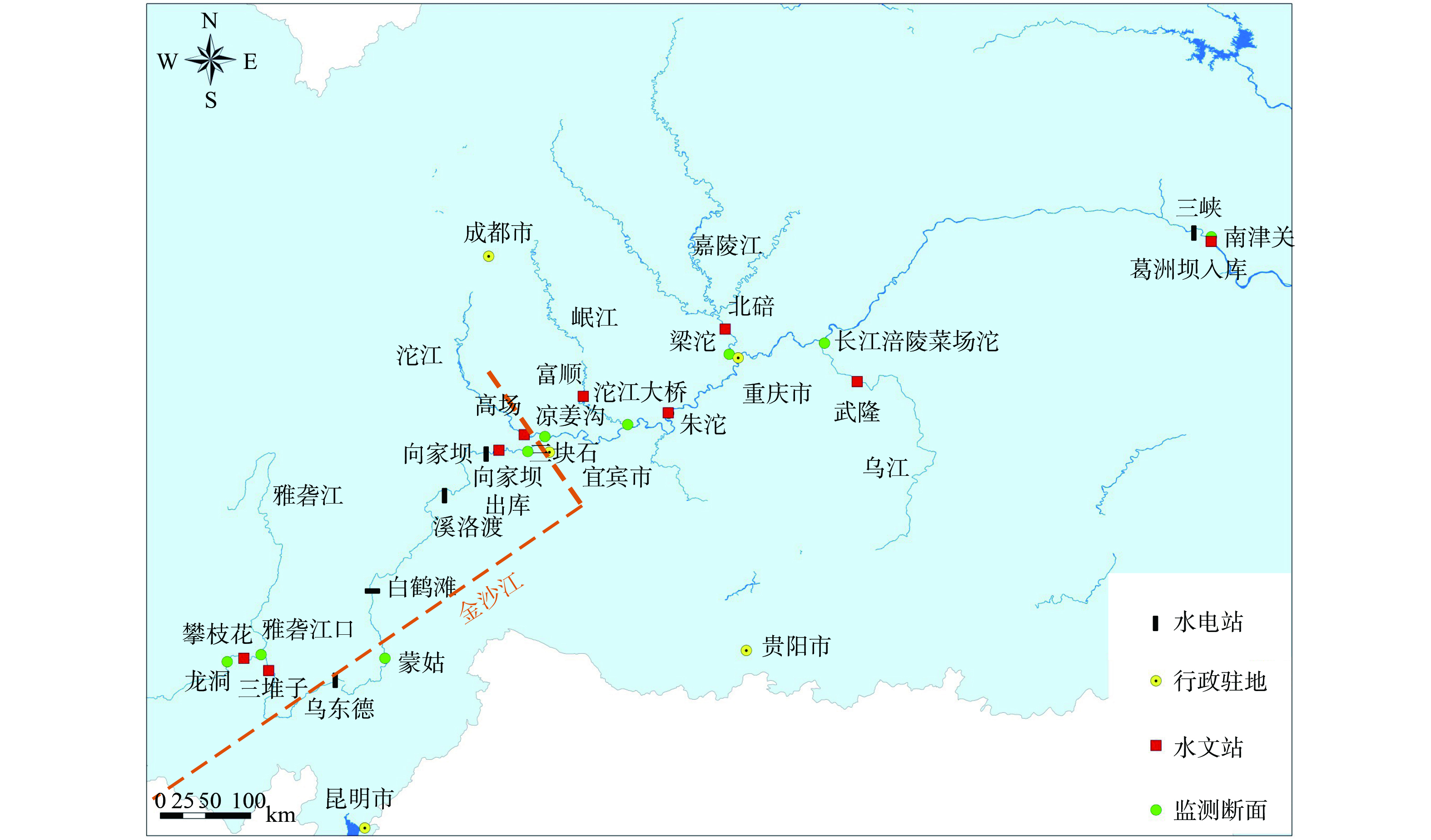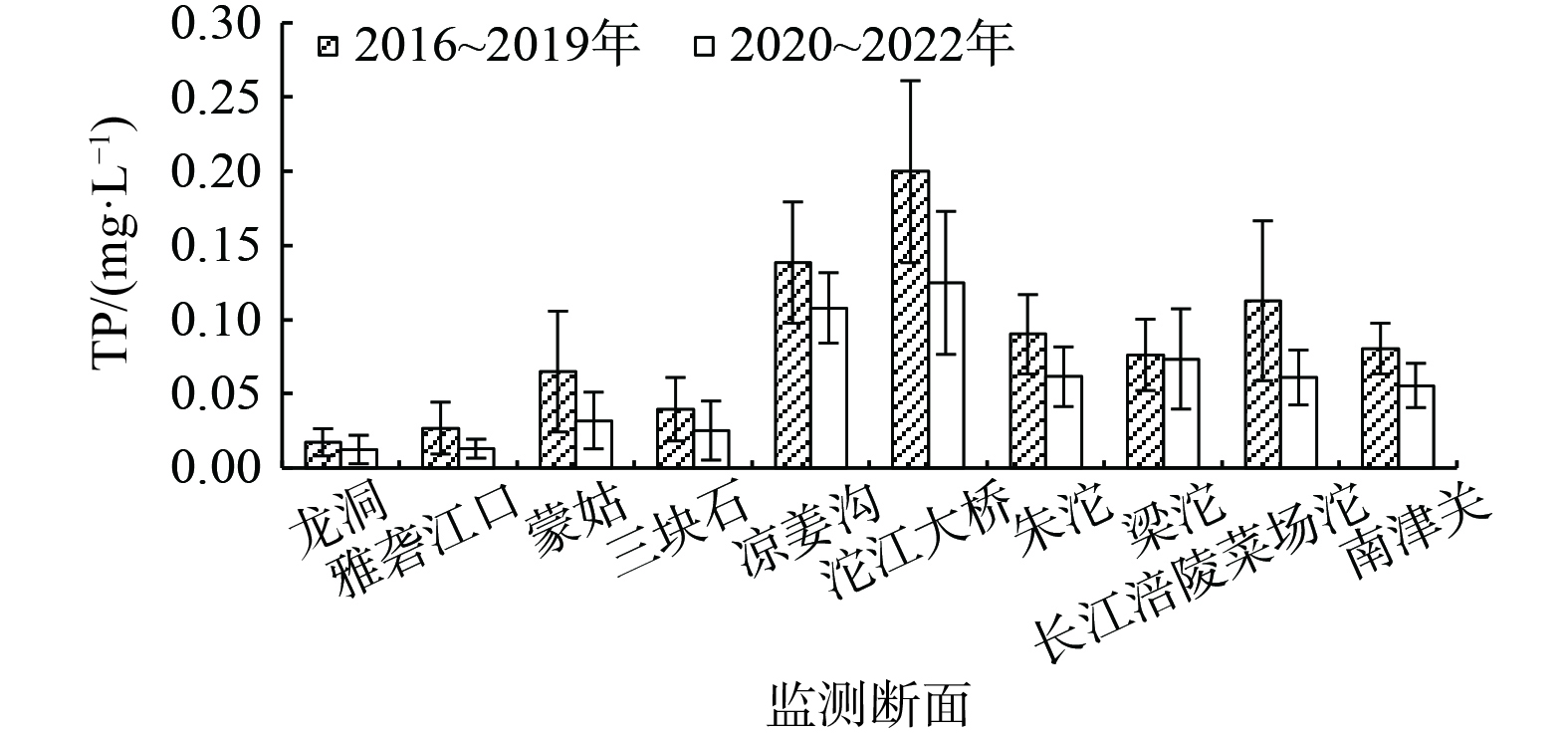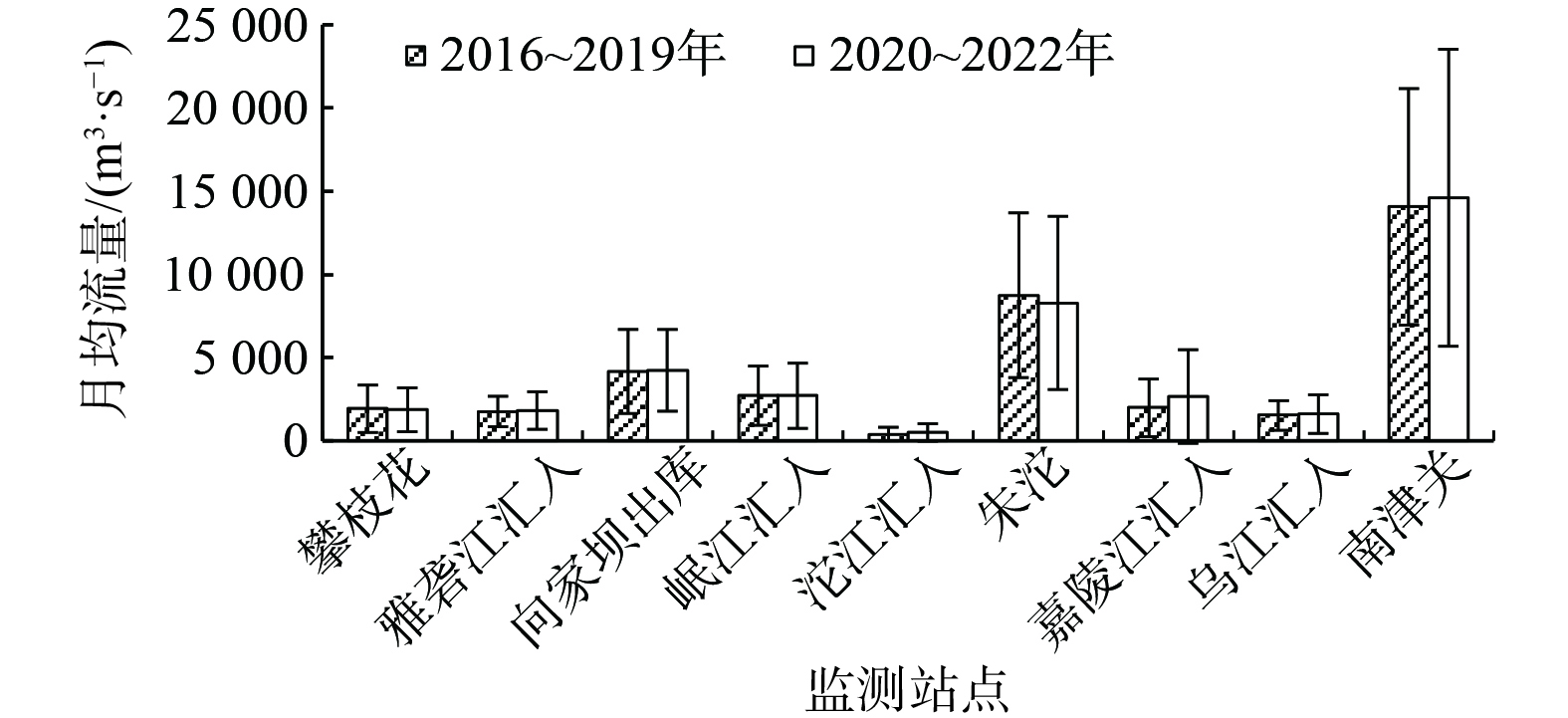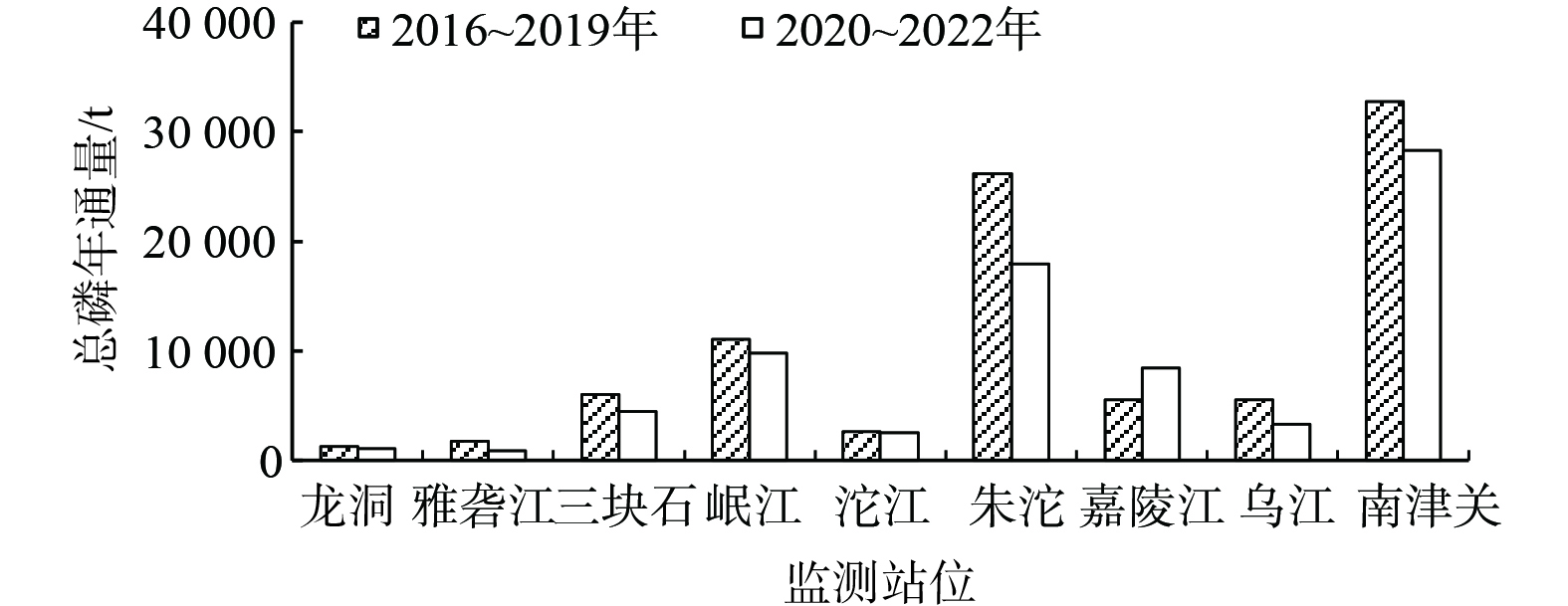-
磷是生命体的必需元素,也是湖库富营养化的关键限制性因子,对浮游动植物、底栖动物群落健康等具有重要作用[1-7]。河流是磷等生源要素的陆海传输通道,长江作为亚洲第一大河流,其磷的时空输移特性对干流和中下游通江湖泊、东海的生态系统结构与功能都具有重要影响[8-11]。
长江从巴塘河口至宜宾“三江口” (金沙江、岷江和长江三江交界处) 为金沙江,宜宾以下称为长江。过去几十年,长江上游和金沙江系列控制性水库的陆续建成投运,极大地改变了天然河流的自然属性和作用过程[12-15]。在河流筑坝形成水库后,上游来水进入库区流速变缓,河流的携沙能力下降,强动力条件下的“河流侵蚀搬运作用”逐渐变成“湖泊沉积作用”[16]。库区水文情势的改变使库内颗粒态磷明显减少,并导致总磷浓度随之下降[17-19]。自2003年三峡大坝建成后,经过了135 m、156 m和175 m试验性蓄水后,于2011年进入高水位正常运用期。已有研究表明,三峡水库对磷存在一定的滞留效应,蓄水试运行阶段,库区干流断面年均总磷在2008年沿程呈明显降低趋势;尤其是2014—2017年金沙江下游溪洛渡和向家坝电站运行后,库区干流断面平均总磷下降45%[20]。
金沙江下游有4个呈串联形式的梯级水电站,从上游往下游依次为乌东德、白鹤滩、溪洛渡和向家坝水电站。向家坝和溪洛渡水电站分别于2012年和2013年投产,乌东德和白鹤滩水电站分别于2020年和2021年投产,其中白鹤滩是装机容量仅次于三峡的世界第二大水电站。梯级水电站拦截了金沙江大量泥沙,对库区水文和泥沙情势产生了较大影响[21-26]。上游来水泥沙量锐减导致三峡入库泥沙随之减少,而由于水体磷与泥沙密切相关[27-28],金沙江4座梯级水电站的运行是否对三峡库区总磷通量产生影响,值得关注与研究。目前,已有研究主要关注向家坝和溪洛渡水电站投产运行后对库区及下游总磷的影响[29-31],而乌东德和白鹤滩投产运行后的影响鲜有报道。
本研究拟通过对2016—2022年三峡库区及主要入库支流和金沙江下游总磷、流量监测成果进行分析,以揭示金沙江下游梯级水电站运行后三峡库区总磷通量的变化,为持续性观测梯级水电站与流域磷迁移的规律奠定基础,为后续评估金沙江下游梯级水电站运行后的水环境效应及流域水质安全保障提供参考。
-
本研究的空间范围为金沙江下游攀枝花至三峡出库南津关干流段。该区域水文气象和地质地貌条件时空差异明显,金沙江段建设有乌东德、白鹤滩、溪洛渡和向家坝4座水电站,从上游到下游还包含雅砻江、岷江、沱江、嘉陵江、乌江等流域面积大于30 000 km2的5条一级支流汇入。
金沙江下游4座水电站为世界已投产的前10大装机容量水电站。4个水电站的控制流域面积广泛,以位于最下游的向家坝水电站为出库站的控制流域面积占三峡大坝控制流域面积的45%[32]。向家坝水电站的多年平均流量约为三峡的1/3,多年平均来沙量2.23×109 t,占三峡宜昌站多年平均来沙量的56%,多年平均含沙量为1.54 kg·m−3,大于三峡宜昌站的0.92 kg·m−3,4座梯级水电站的回水区范围为157~201 km,小于三峡的667 km回水区长度,各电站主要指标见表1[32]。
基于研究范围,选取国家地表水环境质量监测网中10个干流和支流汇入断面的每月总磷进行研究,断面具体为:龙洞、雅砻江口、蒙姑、三块石、凉姜沟、沱江大桥、朱沱、梁沱、长江涪陵菜场沱和南津关。由于乌东德水电站正常蓄水位975 m的回水长度为201 km,位于雅砻江口断面下游,故雅砻江口上游龙洞断面可作为背景断面。蒙姑为乌东德坝下断面,三块石为向家坝坝下断面,朱沱为三峡入库断面,南津关为三峡坝下断面,雅砻江口、凉姜沟、沱江大桥、梁沱、长江涪陵菜场分别为雅砻江、岷江、沱江、嘉陵江、乌江汇入长江干流断面。从空间上看,龙洞、雅砻江口、蒙姑、三块石4个断面为金沙江下游断面,凉姜沟、沱江大桥、朱沱、梁沱、长江涪陵菜场沱和南津关为长江断面。
选取水质断面附近的9个水文站的月均流量数据进行研究,站点具体为攀枝花、三堆子、向家坝出库、高场、富顺、朱沱、北碚、武隆、葛洲坝入库。其中,攀枝花水文站在龙洞断面附近,雅砻江汇入流量用三堆子流量减攀枝花流量计算,南津关流量用葛洲坝入库流量计算,高场、富顺、北碚和武隆水文站分别在凉姜沟、沱江大桥、梁沱、长江涪陵菜场断面附近,分别代表岷江、沱江、嘉陵江和乌江的汇入流量。研究区域和监测站位如图1所示。
-
4座水电站的建设期为2003—2022年,按2组电源分2期开发。第一期工程以向家坝和溪洛渡为一组,2003年开始筹建,2013年全部机组投产;第二期工程以乌东德和白鹤滩为一组,2010年开始筹建,2020年和2021年首批机组分别投产,2021年和2022年底分别全部投产。根据4座水电站分2期开发的特点,选择2016—2022年作为研究时段,同时将2016—2022年划分为2个阶段,即2座电站运行阶段 (2016—2019年) 和4座电站运行阶段 (2020—2022年) 。
采用国家地表水环境质量监测网中长江流域相关断面2016年1月至2022年12月的总磷每月监测数据。国家监测断面数据的采样方式、测定方法和操作步骤等均按《国家监测国家地表水环境质量监测网监测任务作业指导书 (试行) 》要求进行,其中总磷的测定采用钼酸铵分光光度法,取样前仔细摇匀,以得到溶解部分和悬浮部分均具有代表性的试样。由于梁沱和长江涪陵菜场沱为“十四五”新增断面,“十三五”期间水质数据用梁沱附近的大溪沟断面和长江涪陵菜场沱附近的麻柳嘴断面代替。流量数据来源于中国长江三峡集团有限公司流域枢纽运行管理中心。根据研究区域多年逐月平均降水量,将12月到次年3月定义为枯水期,6月到9月定义为丰水期,4月至5月和10月至11月定义为平水期。
-
基于各水质断面的总磷浓度和水文站流量数据,分别计算乌东德上游背景断面 (龙洞) 、雅砻江汇入、向家坝坝下 (三块石) 、岷江汇入、沱江汇入、三峡入库 (朱沱) 、嘉陵江汇入、乌江汇入和三峡出库 (南津关) 的总磷通量。本文中使用的总磷浓度是每月1次的测定值,流量数据是月均值,根据现实条件及通量估算方法筛选中误差最小原则[33],采用式 (1) 和 (2) 计算总磷月通量 (Wm) 和年通量 (Wa) 。
式中:km、ka为单位换算系数;Ci为第i个月的总磷,mg·L−1;Qi为第i个月的月流量,m3·s−1。
采用kendall相关系数对总磷浓度和流量变化趋势进行显著性检验。
-
1) 总磷总体变化特征。2016年,向家坝和溪洛渡水电站已分别安全运行4年和3年。从2016年起,乌东德上游背景断面龙洞至三峡坝下南津关断面年均总磷时空变化情况如图2所示。研究区域总磷主要呈现以下2个特征。在空间上,金沙江下游断面总磷整体低于长江断面总磷,金沙江4个断面平均总磷较长江6个断面平均总磷低71%,其中乌东德上游背景断面龙洞总磷最低,沱江汇入断面总磷最高。在时间上,除嘉陵江汇入断面外,其余断面在4座电站运行阶段总磷均有所降低,乌东德上游背景断面龙洞总磷下降28%,蒙姑下降51%,三块石下降36%,总磷较高的沱江汇入断面下降38%,乌江汇入断面下降46%,三峡入库朱沱下降32%。
2) 各断面总磷浓度随时间变化特征。由于在研究时段内金沙江下游断面总磷整体低于长江断面总磷浓度,分别对龙洞、雅砻江口、蒙姑、三块石4个金沙江下游断面和凉姜沟、沱江大桥、朱沱、梁沱、长江涪陵菜场沱、南津关6个长江断面的总磷年均浓度与年份作图 (图3) 。2个区域总磷浓度的变化特征有2个方面。一方面,乌东德上游背景断面龙洞2016至2021年总磷较稳定,2022年总磷明显降低;雅砻江汇入断面雅砻江口总磷在2017和2018年升高,随后逐渐降低;乌东德坝下断面蒙姑总磷在2018年达到极大值,2019年和2020年降幅较大,2021年达到极小值,2022年又升高;向家坝坝下断面三块石总磷在2016-2019年呈降低现象,2020年明显升高,随后又逐渐降低。另一方面,三峡入库断面朱沱和出库断面南津关在研究时段内年均总磷逐渐降低;岷江汇入断面凉姜沟和沱江汇入断面沱江大桥在研究时段内年均总磷呈波动下降现象,2个断面总磷均在2019年略升高,随后降低;嘉陵江汇入断面梁沱2016至2021年总磷呈波动上升现象,2022年出现降低;乌江汇入断面长江涪陵菜场沱在研究时段内年均总磷呈波动下降现象,2017年达到极大值,随后明显降低。
-
1) 流量总体变化特征。2个阶段干流站点和支流汇入平均流量如图4所示。嘉陵江和沱江在4座电站运行阶段汇入干流的平均流量分别增加了37%和23%,其余站点或支流在2座电站运行阶段和4座电站运行阶段月均流量无明显变化 (显著性检验不显著) 。对三峡入库断面朱沱而言,上游干流来水和岷江、沱江两大支流汇入是其流量的主要来源。在2座电站运行阶段,向家坝出库和岷江、沱江汇入流量之和约占其流量的83%,其中向家坝出库占48%;在4座电站运行阶段,向家坝出库和岷江、沱江汇入流量之和约占其流量的90%,其中向家坝出库占51%。
2) 各站点流量随时间变化特征。研究区域干流站点和支流月均流量的年度变化情况如图5所示。一方面,干流站点的月均流量在研究时段内变化趋势基本一致,均是2020年达到极大值,随后降低。另一方面,支流站点除嘉陵江外,雅砻江、岷江、沱江和乌江汇入的月均流量在研究时段内变化趋势总体一致,均在2020年达到极大值,而嘉陵江则是2021年达到极大值。
-
1) 通量总体变化特征。2个阶段总磷年均通量结果如图6所示。一方面,乌东德上游背景断面龙洞、雅砻江汇入、向家坝坝下断面三块石、岷江汇入、三峡入库、乌江汇入和三峡出库的总磷年均通量在4座电站运行阶段均出现一定程度降低,降幅较大的为雅砻江、乌江和三峡入库朱沱。另一方面,沱江在2个阶段的总磷年均通量变化不大,嘉陵江在4座电站运行阶段的总磷年均通量较2座电站运行阶段增加了52%。
2) 通量随时间变化特征。研究区域干流断面和支流汇入的总磷年通量随时间变化情况如图7所示。一方面,向家坝坝下断面三块石的总磷通量在2020年明显升高,随后减低,但三峡入库断面朱沱的总磷通量并未在2020年出现极大值。另一方面,嘉陵江汇入的总磷通量在2016至2021年呈上升现象,在2021年达到极大值,2022年下降;岷江和沱江的变化趋势基本一致,呈先降低再升高,2020年达到峰值,2021和2022年下降的现象;雅砻江和乌江的总磷通量在研究时段内波动降低。
-
从2个阶段总磷浓度的变化情况可以看出,除嘉陵江汇入断面外,其余断面在4座电站运行阶段总磷均有所降低。总磷降低的主要原因可能与长江大保护和“三磷”治理有关。2016年以来,在“共抓大保护,不搞大开发”的战略定位和《长江保护修复攻坚战行动计划》等文件的落实下,极大改善了长江流域总体水质。同时,针对长江流域“三磷”问题,2019年印发的《长江“三磷”专项排查整治行动实施方案》进一步促进了总磷降低。通过研究区域总磷丰水期和枯水期的分析可佐证点源治理的成效。研究区域总磷水期变化特征如图8所示。岷江汇入断面凉姜沟和乌江汇入断面长江涪陵菜场沱的总磷在2座电站运行阶段是枯水期高于丰水期,而在4座电站运行阶段则是丰水期高于枯水期;沱江汇入断面沱江大桥的丰水期与枯水期总磷差异在4座电站运行阶段明显大于2座电站运行阶段。岷江、沱江和乌江流域是磷矿、磷化工企业和磷石膏库的主要分布区域,从其汇入断面在4座电站运行阶段总磷丰水期高于枯水期可进一步说明点源逐步治理。
另外,梯级电站对泥沙的拦截可能是三峡入库总磷浓度降低的另一原因。磷与泥沙之间具有强烈的亲和力,磷离子极易与泥沙结合形成颗粒态磷。金沙江是三峡入库泥沙的主要来源,梯级水电站对金沙江泥沙的拦截情况决定了三峡入库泥沙通量的变化[22-24]。2012年梯级水电站陆续蓄水运行,拦截金沙江的泥沙,2013—2020年向家坝出库年平均输沙量降至152×104 t,相较于蓄水前均值减幅超99%[25]。梯级水电站显著的拦沙作用使得三峡水库入库泥沙量大幅度减小,入库泥沙颗粒变细,三峡水库库尾泥沙淤积强度减小,甚至出现冲刷[26]。由于泥沙和悬浮物数据缺失,故本研究用4座电站运行阶段浊度数据与总磷浓度进行相关性分析,结果如表2所示。三峡入库总磷与泥沙呈显著正相关,梯级水电站的拦沙作用对三峡入库总磷的降低可能有一定贡献。此外,还需进一步关注总磷未明显降低的嘉陵江,重视嘉陵江流域的污染防治。
-
4座水电站的运行使得梯级水电站的调蓄作用进一步加强。4座梯级水电站运行前后流量变化的分析结果表明,4座电站运行阶段向家坝坝下断面三块石的流量波动 (图4中向家坝出库站点对应的标准差) 小于2座电站运行阶段。
尽管梯级水电站起到一定的调蓄作用,但三峡入库流量波动在4座电站运行阶段并未变小 (图4中朱沱站点对应的标准差) 。分析其原因可能是梯级水电站下游支流对三峡入库流量影响更大。在研究时段内,向家坝出库流量约占三峡入库流量的一半左右,支流汇入对三峡入库流量的影响不容忽视。
-
分别对2座电站运行阶段和4座电站运行阶段乌东德上游背景断面龙洞、向家坝坝下断面三块石、三峡入库断面朱沱和出库断面南津关,以及雅砻江、岷江、沱江、嘉陵江和乌江5条重要支流汇入的总磷年通量绘制概化图,如图9所示。
1) 梯级水电站的源汇作用。向家坝坝下断面三块石输出通量大于乌东德上游背景断面龙洞和雅砻江汇入的通量之和,这说明梯级水电站是总磷的释放源,可能与溪洛渡和向家坝泥沙颗粒淤积后释放磷有关。在2座电站运行阶段,释放量约为3 029 t,而在4座电站运行阶段,释放量约为2 561 t,这说明乌东德和白鹤滩的运行使总磷的释放量有所减少。这可能是乌东德和白鹤滩蓄水造成,也可能是乌东德和白鹤滩的运行改变了坝下水动力条件,导致溪洛渡和向家坝水流扰动减小,沉积物释放变弱,总磷释放减少。
2) 梯级水电站对三峡入库总磷通量的贡献。根据尹真真等[33]的研究,三峡库区重庆段总磷主要来自外域输入,其中长江朱沱、嘉陵江和乌江等境外输入负荷占出境负荷的88%~93.5%,流域内点源、面源、内源等污染源总磷负荷仅占出境负荷的12%左右。同时,由于向家坝出库和岷江、沱江汇入流量之和占三峡入库朱沱流量的80%以上,故本研究聚焦于三峡库区总磷的主要来源,不考虑三峡库区内点源、面源、内源等污染源,探讨梯级水电站对三峡入库总磷通量的贡献情况。
对三峡库区而言,其入库总磷通量主要贡献来自于长江干流入库断面朱沱、嘉陵江和乌江。2座电站运行阶段,朱沱、嘉陵江、乌江年均入库总磷通量分别为26 201、5 542、5 523 t。4座电站运行阶段,朱沱、嘉陵江、乌江年均入库总磷通量分别为17 965、8 425、3 296 t。4座电站运行阶段,朱沱和乌江汇入总磷通量降低了31%和40%,而嘉陵江汇入总磷通量增加了52%。4座电站运行阶段,朱沱对三峡库区入库总磷通量的贡献率由2座电站运行阶段的70%降至61%,乌江贡献率由15%降至11%,嘉陵江的贡献率则由15%增至28%。
由于三峡入库断面朱沱总磷通量有所降低,因此进一步分析上游来水和和支流汇入的变化情况。对三峡入库断面朱沱的总磷通量而言,主要贡献来自于向家坝出库、岷江和沱江总磷输入。4座电站运行阶段,向家坝出库和岷江汇入总磷通量的减少共同导致三峡入库总磷通量的减少。从贡献率上看,在4座电站运行阶段,向家坝出库对三峡入库总磷通量的贡献率由两座电站运行阶段的31%降至26%,其贡献率是否会随着金沙江下游4座梯级水电站的运行进一步降低还需持续关注。另外,对在4座电站运行阶段总磷汇入通量增加的嘉陵江也需加强其水污染防治措施,进一步降低嘉陵江流域总磷。随着未来乌东德和白鹤滩对总磷滞留效应的显现,上游干流来磷量可能会进一步减少,嘉陵江等支流对三峡库区总磷的贡献可能会进一步增加,故需更重视支流总磷的输入。
-
1) 金沙江下游断面总磷整体低于长江断面总磷,其中乌东德上游背景断面龙洞总磷最低,沱江汇入断面总磷浓度最高。除嘉陵江汇入断面外,其余断面在4座电站运行阶段总磷均有所降低。嘉陵江汇入断面2016至2021年总磷呈波动上升现象,2022年出现降低。长江大保护和“三磷”治理可能是总磷降低的主要原因,梯级水电站的拦沙作用对三峡入库总磷的降低可能也有一定贡献。
2) 向家坝出库流量约占三峡入库流量的一半左右。4座水电站的运行使得梯级水电站的调蓄作用进一步加强,但三峡入库流量波动在4座电站运行阶段并未变小,支流汇入对三峡入库流量的影响不容忽视。
3) 除沱江和嘉陵江外,其余断面总磷年均通量在4座电站运行阶段均出现一定程度降低,沱江在2个阶段的总磷年均通量变化不大,嘉陵江在4座电站运行阶段的总磷年均通量较2座电站运行阶段增加了52%。从三峡入库总磷通量的贡献率上看,向家坝出库对三峡入库总磷通量的贡献率由2座电站运行阶段的31%降至4座电站运行阶段的26%,需持续关注金沙江梯级水电站的源汇作用和其对三峡入库总磷的影响。
金沙江梯级水电站运行后三峡库区总磷通量变化分析
Change of total phosphorus flux in the Three Gorges Reservoir area after the operation of the Jinsha river cascade hydropower station
-
摘要: 金沙江下游从上往下依次建设有乌东德、白鹤滩、溪洛渡和向家坝4个呈串联形式的梯级水电站,这4座大型水利工程的建设运行对下游水文情势产生了重要影响,并随之影响磷的迁移过程。基于4座梯级水电站的建设运行特点,将研究时间划分为2座电站运行阶段 (2016—2019年) 和4座电站运行阶段 (2020—2022年) 。通过分析2个阶段金沙江下游攀枝花至三峡出库南津关干流段监测站位总磷、流量和通量的变化情况,阐明金沙江下游梯级水电站运行对三峡库区总磷通量的影响程度。除嘉陵江汇入断面外,其余断面在4座电站运行阶段总磷浓度均有所降低。4座水电站的运行使得梯级水电站的调蓄作用进一步加强,但三峡入库流量波动在4座电站运行阶段并未变小,支流汇入对三峡入库流量的影响不容忽视。除沱江和嘉陵江外,其余断面总磷年均通量在4座电站运行阶段均出现一定程度的降低,沱江在2个阶段的总磷年均通量变化不大,嘉陵江在4座电站运行阶段的总磷年均通量较两座电站运行阶段增加了52%。向家坝出库对三峡入库总磷通量的贡献率由2座电站运行阶段的31%降低到4座电站运行阶段的26%,需持续关注金沙江梯级水电站的源汇作用和其对三峡入库总磷的影响。该研究结果可为持续性观测梯级水电站与流域磷迁移的规律提供参考。Abstract: In the downstream of Jinsha River, four cascade hydropower stations were constructed successively, namely Wudongde, Baihetan, Xiluodu and Xiangjiaba. The construction and operation of these four large-scale hydropower projects had an important impact on the downstream hydrological situation, and in turn affected the migration process of phosphorus. Based on the construction and operation characteristics of four cascade hydropower stations, the research period was divided into two hydropower stations operation stage (2016-2019) and hydropower stations operation stage (2020-2022). By analyzing the changes of total phosphorus (TP) concentration, flow and flux at monitoring stations from Panzhihua to Nanjiguan section in the two stages, the influence of cascade hydropower station on TP flux in the Three Gorges reservoir area was illustrated. Except for the Jialing River inlet section, the TP concentration of the other sections decreased during the four hydropower stations operation stage. The operation of the four hydropower stations further strengthened the regulating effect of the cascade hydropower stations, but the fluctuation of the inflow flow of the Three Gorges is not reduced during the four hydropower stations operation stage, which meant that the influence of the inflow flow of the Three Gorges could not be ignored. Except for the Tuojiang River and Jialing River, the average annual TP flux of the other sections decreased to a certain extent during the four hydropower stations operation stage. The average annual TP flux of the Tuo River in the two hydropower stations operation stage did not change significantly, and the average annual TP flux of the Jialing River in the four hydropower stations operation stage increased by 52% compared with that in the two hydropower stations operation stage. The contribution of Xiangjiaba TP discharge to the TP flux of the Three Gorges reservoir decreased from 31% in the two hydropower stations operation stage to 26% in the four hydropower stations operation stage. It is necessary to pay attention to the source and sink effect of the cascade hydropower station on the Jinsha River and its influence on the TP of the Three Gorges Reservoir. This result can provide a reference for continuous observation of the phosphorus migration in Changjiang river basins after the operation of the cascade hydropower stations.
-

-
表 1 金沙江下游4座梯级水电站及三峡水电站的主要指标特点
Table 1. The main index characteristics of four cascade hydropower stations in the lower reaches of Jinsha River and the Three Gorges Hydropower Station
水电站 控制流域
面积/km2多年平均
流量/ (m3·s−1)水库回水
长度/km正常蓄
水位/m多年平均
来沙量/t多年平均
含沙量/ (kg·m−3)开发建设阶段 乌东德 4.06×105 3 830 201 975 — — 已全部投产 白鹤滩 4.30×105 4 170 183 825 — — 2022年底全部投产 溪洛渡 4.54×105 4 570 194 600 — — 安全运行9年 向家坝 4.59×105 4 570 157 380 2.23×108 1.54 安全运行10年 三 峡 1.01×106 13 600 667 175 3.97×108 0.92 安全运行19年 表 2 总磷浓度与浊度相关性分析
Table 2. Correlation analysis between TP and turbidity
相关性指标 龙洞 三块石 朱沱 南津关 回归方程 y = 1 354x − 2.8 y = −247x+17.0 y = 1 791x − 61.8 y = 1 217x − 47.4 R2 0.72 0.06 0.61 0.45 相关系数 0.566** −0.118 0.601** 0.270 -
[1] WETZEL R. Limnology: lake and river ecosystems . San Diego: Academic Press, 2001: 204-238. [2] TAUBE N, RYAN M C, HE J, et al. Phosphorus and nitrogen storage, partitioning, and export in a large gravel bed river[J]. Science of the Total Environment, 2019, 657: 717-730. doi: 10.1016/j.scitotenv.2018.11.431 [3] 杨中华, 杨水草, 李丹, 等. 三峡水库支流小江富营养化模型构建及在水量调度控藻中的应用[J]. 湖泊科学, 2016, 28(4): 755-764. doi: 10.18307/2016.0408 [4] MULLER B, FINGER D, STURM M, et al. Present and past bio-available phosphorus budget in the ultra-oligotrophic Lake Brienz[J]. Aquat Sciences, 2007, 69(2): 227-239. doi: 10.1007/s00027-007-0871-8 [5] 张晓晓, 姚庆祯, 陈洪涛, 等. 黄河下游营养盐浓度季节变化及其入海通量研究[J]. 中国海洋大学学报, 2010, 40(7): 82-88. [6] NIXON S W. Replacing the Nile: Are anthropogenic nutrients providing the fertility once brought to the mediterranean by a great river?[J]. Royal Swedish Academy of Sciences, 2003, 32(1): 30-39. [7] FORSBERG B R, DEVOL A H, RICHEY J E, et al. Factors controlling nutrient concentrations in Amazon floodplain lakes[J]. Limnology and Oceanography, 1988, 33(1): 41-56. doi: 10.4319/lo.1988.33.1.0041 [8] DUAN S W, LIANG T, ZHANG S, et al. Seasonal changes in nitrogen and phosphorus transport in the lower Changjiang River before the construction of the Three Gorges Dam[J]. Estuarine, Coastal and Shelf Science, 2008, 79(2): 239-250. doi: 10.1016/j.ecss.2008.04.002 [9] LI M T, XU K Q, WATANABE M, et al. Long-term variations in dissolved silicate, nitrogen, and phosphorus flux from the Yangtze River into the East China Sea and impacts on estuarine ecosystem[J]. Estuarine, Coastal and Shelf Science, 2007, 71: 3-12. doi: 10.1016/j.ecss.2006.08.013 [10] CHAI C, YU Z M, SHEN Z L, et al. Nutrient characteristics in the Yangtze River Estuary and the adjacent East China Sea before and after impoundment of the Three Gorges Dam[J]. Science of the Total Environment, 2009, 407: 4687-4695. doi: 10.1016/j.scitotenv.2009.05.011 [11] 尹炜, 王超, 张洪. 长江流域总磷问题思考[J]. 人民长江, 2022, 53(4): 44-52. [12] 冉祥滨, 于志刚, 姚庆祯, 陈洪涛, 米铁柱, 姚鹏. 水库对河流营养盐滞留效应研究进展[J]. 湖泊科学, 2009, 21(5): 614-622. doi: 10.3321/j.issn:1003-5427.2009.05.002 [13] 周建军, 张曼, 李哲. 长江上游水库改变干流磷通量、效应与修复对策[J]. 湖泊科学, 2018, 30(4): 865-880. doi: 10.18307/2018.0401 [14] 卓海华, 娄保锋, 吴云丽, 王瑞琳, 陈杰, 兰静. 新水沙条件下长江中下游干流水体总磷时空变化分析[J]. 环境科学, 2020, 41(12): 5371-5380. [15] 林莉, 董磊, 潘雄, 杨文俊, 等. 三峡水库蓄水后库区水沙变化及其生态环境响应特征[J]. 湖泊科学, 2023, 35(2): 411-422. [16] 刘丛强, 汪福顺, 王雨春, 等. 河流筑坝拦截的水环境响应——来自地球化学的视角[J]. 长江流域资源与环境, 2009, 18(4): 384-396. doi: 10.3969/j.issn.1004-8227.2009.04.015 [17] MAAVARA T, PARSONS C T, RIDENOUR C, et al. Global phosphorus retention by river damming[J]. Proceedings of the National Academy of Science, 2015, 112(51): 15603-15608. doi: 10.1073/pnas.1511797112 [18] DING S, CHEN P P, LIU S M, et al. Nutrient dynamics in the Changjiang and retention effect in the Three Gorges Reservoir[J]. Journal of Hydrology, 2019, 574: 96-109. doi: 10.1016/j.jhydrol.2019.04.034 [19] ZHOU J J, ZHANG M, LIN B L, et al. Lowland fluvial phosphorus altered by dams[J]. Water Resources Research, 2015, 51: 2211-2226. doi: 10.1002/2014WR016155 [20] 翟婉盈, 湛若云, 卓海华, 等. 三峡水库蓄水不同阶段总磷的变化特征[J]. 中国环境科学, 2019, 39(12): 5069-5078. [21] 唐小娅, 童思陈, 黄国鲜, 等. 三峡水库总磷时空变化特征及滞留效应分析[J]. 环境科学, 2020, 41(5): 2096-2106. [22] 朱玲玲, 董先勇, 陈泽方. 金沙江下游梯级水库淤积及其对三峡水库影响研究[J]. 长江科学院院报, 2017, 34(3): 5-11. [23] 王殿常, 吴兴华. 三峡水库磷输移规律研究[J]. 水利学报, 2021, 52(8): 885-895. [24] 秦蕾蕾, 董先勇, 杜泽东等. 金沙江下游水沙变化特性及梯级水库拦沙分析[J]. 泥沙研究, 2019, 44(3): 24-30. [25] 朱玲玲, 陈迪, 杨成刚, 等. 金沙江下游梯级水库泥沙淤积和坝下河道冲刷规律[J]. 湖泊科学, 2023, 35(3): 1097-1110. [26] 杨凡, 王丽婧, 纪道斌, 等. 三峡水库典型支流磷素赋存形态特征及其成因[J]. 环境科学, 2021, 42(2): 688-698. [27] 鲍林林, 李叙勇, 苏静君. 筑坝河流磷素的迁移转化及其富营养化特征[J]. 生态学报, 2017, 37(14): 4663-4670. [28] 刘尚武, 张小峰, 吕平毓, 等. 金沙江下游梯级水库对氮、磷营养盐的滞留效应[J]. 湖泊科学, 2019, 31(3): 656-666. [29] 李思璇, 宋瑞, 许全喜, 等. 长江上游总磷通量时空变化特征研究[J]. 环境科学与技术, 2021, 44(5): 179-185. [30] 王耀耀, 吕林鹏, 纪道斌, 等. 向家坝水库营养盐时空分布特征及滞留效应[J]. 环境科学, 2019, 40(8): 3530-3538. [31] 樊启祥, 张超然, 洪文浩, 等. 金沙江下游梯级水电工程建设风险管理实践[J]. 水力发电学报, 2023, 42(3): 118-131. [32] 娄保锋, 卓海华, 周正, 等. 近18年长江干流水质和污染物通量变化趋势分析[J]. 环境科学研究, 2020, 33(5): 1150-1162. [33] 尹真真, 赵丽, 彭昱, 等. 三峡库区重庆段总磷污染来源解析及控制对策[J]. 环境工程技术学报, 2018, 8(1): 51-57. -




 下载:
下载:









